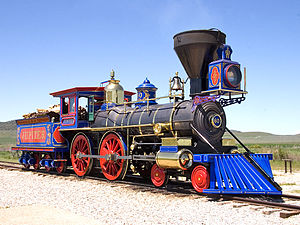Jupiter (locomotive)

Jupiter replica at Golden Spike N.H.S.
|
|||||||||||||
|
|||||||||||||
|
|||||||||||||
|
|||||||||||||
| Type and origin | |
|---|---|
| Power type | Steam |
| Builder |
Schenectady Locomotive Works (original) O'Connor Engineering Laboratories (replica) |
| Serial number | 505 |
| Build date | September 1868 (original) 1979 (replica) |
| Specifications | |
|---|---|
| Configuration | 4-4-0 |
| Gauge | 4 ft 8 1⁄2 in (1,435 mm) |
| Fuel type | Wood, converted to coal in 1893 |
| Career | |
|---|---|
| Operators | Central Pacific Railroad, Southern Pacific Railroad, Gila Valley, Globe and Northern Railroad |
| Numbers | 60 (CP), renum 1195 in 1891, GVG&N 1 in 1893 |
| Official name | Jupiter |
| First run | March 20, 1869 |
| Disposition | Original scrapped. Replica operational at the Golden Spike N.H.S.. |
The Jupiter (officially known as Central Pacific Railroad #60) was a 4-4-0 steam locomotive which made history as one of the two locomotives (the other being the Union Pacific No. 119) to meet at Promontory Summit during the Golden Spike ceremony commemorating the completion of the First Transcontinental Railroad.
The Jupiter was built in September 1868 by the Schenectady Locomotive Works of New York, along with three other engines, numbered 61, 62, and 63, named the Storm, Whirlwind, and Leviathan, respectively. These four engines were then dismantled and sailed to San Francisco, California, where they were loaded onto a river barge and sent to the Central Pacific headquarters in Sacramento, then reassembled and commissioned into service on March 20, 1869.
The Jupiter was not Leland Stanford's original choice for transporting his party to the Golden Spike site. Originally, Stanford's train was to be pulled by another Central Pacific locomotive, the Antelope. For some distance, this train followed closely behind a regularly scheduled train pulled by the Jupiter. However, at one point the two trains were to go through a cut where a logging camp resided atop the hill. Apparently, either the Jupiter did not wear the proper flag to designate an extra following close behind, or the workers had failed to notice the flag. As a result, once the Jupiter passed, the workers rolled a large log down the mountain, which struck the Antelope. With the engine damaged, a message was sent to the upcoming station to hold the approaching train. There, Stanford's consist was added to the Jupiter's train.
After the ceremony, Jupiter continued in service for the Central Pacific. In the 1870s, the railroad decided to end their practice of naming their engines, and thus, the Jupiter name was dropped and the engine was simply known as C.P. #60. The locomotive also received many new upgrades such as a new boiler, cowcatcher, domes, and smokestack. In 1891, the Southern Pacific, which acquired the Central Pacific in 1885, began renumbering its locomotives. As part of this renumbering, the former Jupiter engine #60 became S.P. #1195. In 1893 it was converted to burn coal, and later that year was sold to the Gila Valley, Globe and Northern Railroad and designated GVG&N #1. In 1909 the locomotive which no longer resembled the original Jupiter was sold to scrappers for $1,000.
...
Wikipedia
